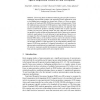Free Online Productivity Tools
i2Speak
i2Symbol
i2OCR
iTex2Img
iWeb2Print
iWeb2Shot
i2Type
iPdf2Split
iPdf2Merge
i2Bopomofo
i2Arabic
i2Style
i2Image
i2PDF
iLatex2Rtf
Sci2ools
BRAIN
2010
Springer
2010
Springer
Sparse Regression Models of Pain Perception
Discovering brain mechanisms underlying pain perception remains a challenging neuroscientific problem with important practical applications, such as developing better treatments for chronic pain. Herein, we focus on statistical analysis of functional MRI (fMRI) data associated with pain stimuli. While the traditional mass-univariate GLM [8] analysis of pain-related brain activation can miss potentially informative voxel interaction patterns, our approach relies instead on multivariate predictive modeling methods such as sparse regression (LASSO [17] and, more generally, Elastic Net (EN) [18]) that can learn accurate predictive models of pain and simultaneously discover brain activity patterns (relatively small subsets of voxels) allowing for such predictions. Moreover, we investigate the effect of temporal (time-lagged) information, often ignored in traditional fMRI studies, on the predictive accuracy and on the selection of brain areas relevant to pain perception. We demonstrate that...
| Added | 13 Jan 2011 |
| Updated | 13 Jan 2011 |
| Type | Journal |
| Year | 2010 |
| Where | BRAIN |
| Authors | Irina Rish, Guillermo A. Cecchi, Marwan N. Baliki, A. Vania Apkarian |
Comments (0)

